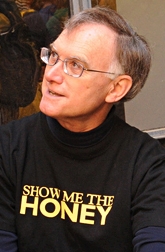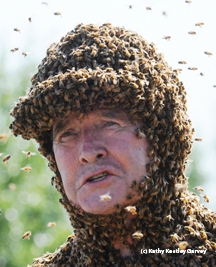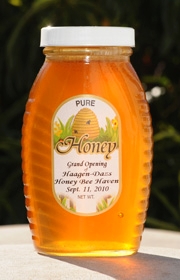Posts Tagged: Eric Mussen
The fruits of their labors
Summer time...and the livin' is easy.
But not for the bees. Worker bees, which live about four to six weeks, literally work themselves to death gathering nectar, pollen, propolis (plant resin) and water to bring back to their colony.
So, when you sit down to summer meals, you can thank a bee.
Extension apiculturist Eric Mussen of the UC Davis Department of Entomology and Nematology, says one-third of the American diet is pollinated by bees. Without bees, we'd be eating such wind-pollinated grains as wheat and rice.
Our gardens and orchards yield such favorites as carrots, cucumbers, onions, apples, grapefruit, oranges, pears, cherries, raspberries, strawberries, blueberries, lima beans, sunflowers and almonds.
All pollinated by honey bees.
Cole crops, such as cabbage, Brussel sprouts, collards, kale, kohlrabi, spinach, chard and broccoli?
All pollinated by honey bees.
Even milk and ice cream are linked closely to the honey bee. Cows feed on alfalfa, which is pollinated by honey bees (along with other bees). Ice cream ingredients usually include fruits and nuts, other bee favorites.
The ever-popular fruit salad features blueberries, apples, oranges and pomegranates.
All pollinated by honey bees.
An apple a day may keep the doctor away, but without the bees, we'd have no apples.
Love apples and honey? Here are two recipes from the National Honey Board celebrating both honey and apples.
Apple honey crisp
2 lbs. apples, quartered and sliced (1-1/2 quarts)
1/2 cup plus 1/4 cup honey, (separated)
1 teaspoon cinnamon
1/2 teaspoon nutmeg
1 cup flour
1/4 cup butter, softened
Warm Nutmeg Cream, (recipe follows) or ice cream
Toss apples with 1/2 cup honey, cinnamon and nutmeg in bowl. Turn into 2-quart baking dish. For topping, beat flour with butter and 1/4 cup honey until crumbly; sprinkle over apples. Bake at 350 degrees for 40 to 45 minutes or until apples are tender and topping is golden. Serve with warm nutmeg cream or ice cream.
Warm nutmeg cream
1/2 cup whipping cream
2 tablespoons honey
2 tablespoons butter
1/4 teaspoon nutmeg
Combine all ingredients in saucepan and bring to boil. Simmer, stirring often, for 5 minutes or until mixture thickens slightly.
Honey apple cake
1/3 cup butter or margarine
1/3 cup packed brown sugar
2 eggs
1/3 cup honey
1 teaspoon grated lemon peel
1-1/2 cups flour
1 teaspoon baking powder
1/2 teaspoon baking soda
1/2 teaspoon ground cinnamon
1/4 teaspoon salt
1/4 teaspoon ground nutmeg
1/8 teaspoon ground allspice
1/4 cup water
1 cup (1 medium) pared, cored, & chopped apple
1/4 cup chopped walnuts
Honey Apple Topping
Cream butter and sugar until light and fluffy. Add eggs, one at a time; beat after each addition. Beat in honey and lemon peel. Combine flour, baking powder, soda, spices and salt; mix well. Add to creamed mixture alternately with water; begin and end with dry ingredients. Stir in apples and nuts. Turn into greased and floured 9-inch heart-shaped or round cake pan. Bake at 325 degrees F. for 45 to 55 minutes or until wooden toothpick inserted near center comes out clean. Cool 10 minutes and remove from pan. Cool completely. Brush top of cake with sauce from honey apple topping; arrange topping on cake.
Honey apple topping
1/3 cup honey
2 tablespoons rosé wine
2 tablespoons lemon juice
2 medium apples
Heat honey, rosé wine and lemon juice. Core and slice 2 medium apples; add to honey. Cook until tender and glazed; turn slices halfway through cooking. Makes topping for one 9-inch cake.
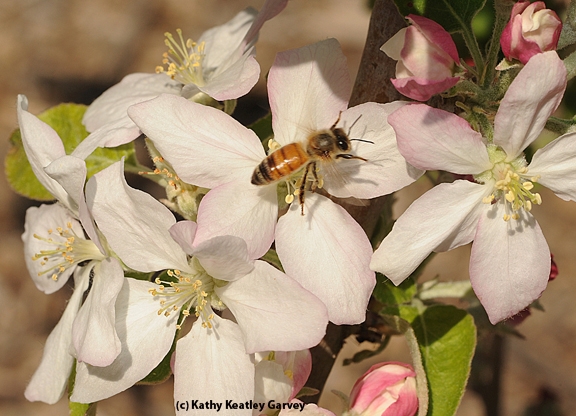
Honey bee pollinating apple blossom. (Photo by Kathy Keatley Garvey)
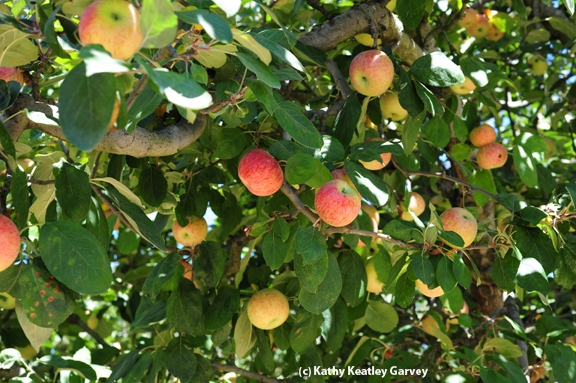
Gravenstein apples ready to be picked. (Photo by Kathy Keatley Garvey)
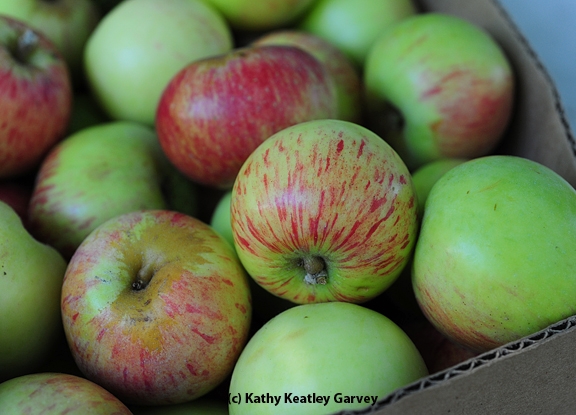
Gravenstein apples ready to eat. (Photo by Kathy Keatley Garvey)
Honey, I hardly know you!
“My jar of honey went bad so I threw it away.”
How many times have you heard that?
It did not go “bad” but it did granulate, as honeys do. Granulation is the formation of sugar (glucose) crystals. Reheat the honey and it’s good to go — and eat.
“Most honeys granulate during storage after extended periods of time in containers,” says honey bee specialist/bee wrangler/six-decade beekeeper Norman Gary, emeritus professor in the Department of Entomology at UC Davis and author of the best-selling beginning beekeeping book, Honey Bee Hobbyist: The Care and Keeping of Bees.
“Sometimes honey granulates while still sealed in the comb,” Gary says. ”The basic reason honey granulates is that the bees have dissolved more sugar in the solution — a process called super saturation — than it can hold during storage. The tendency to granulate is determined primarily by the concentration of glucose. Excess glucose forms crystals of glucose hydrate that aggregate in a lattice in the honey."
Eric Mussen, UC Cooperative Extension specialist in Department of Entomology at UC Davis, says that nearly every variety of honey granulates over time, “since it is a supersaturated sugar solution. Hazy, crystallized, or solidified honey is not spoiled. Loosen the cap and place the container in hot water – the honey will return to its liquid state with stirring. When the sugar crystals release free water in honey, it can ferment. At that point it cannot be salvaged.”
Short-bursts in the microwave are also a good way to liquefy honey, Gary says. He advocates heating the glass jars in 30-second intervals, stopping and stirring.
“Monitor the temperature so you don’t have to heat more than necessary to achieve liquefaction.” High temperatures can "cause chemical changes that some purists consider to be heat damage.” It can also change the delicate flavors and darken the honey.
Some honeys do not crystallize or crystallize so readily. Tupelo honey, produced from the nectar of tupelo trees, does not granulate, Gary says.
As for the taste of honey, Mussen points out that honey tastes sweeter than sucrose “since it contains free fructose, which tastes sweeter to us than does sucrose. There also is free glucose in honey, but that does not taste exceptionally sweet to us.”
Meanwhile, misconceptions about honey continue to persist. Bees make honey from nectar secreted from flowers. Uninformed children may think brown cows give chocolate milk and that different colors of bees account for the different colors of honey. (Even a business professional told me last week that she thought that a specific honey bee makes orange blossom honey, and another bee makes clover honey.)
“The colors and flavors of honey are properties of the nectar collected by the bees, not of the bees producing the honey,” Mussen says. “Climate impacts the nectar. Honey produced from alfalfa bloom can be transparent or 'water white;' golden, as in 'clover' honey, or significantly darker, approaching amber, when it is produced in northern Canada, mid-western U.S., or southern U.S., respectively. If you wish to find specific varieties of honey to compare, many varieties and sources can be found at http://www.honeylocator.com/, overseen by the National Honey Board.”
Mead is another term that puzzles folks. It's an alcoholic beverage made with honey.
“Honey is the basic source of sugar for the fermentation of mead," Mussen explains. "Meads can be dry or sweet, depending upon the desire of the mead maker. With the addition of spices or fruit juices, meads are called various names: metheglin, hippocras, cyser or pymet.”
And, if you cook with honey, be aware of the properties.
“In baking and beverages honey often can be substituted directly for sugar,” Mussen says. “Lighter colored honeys usually are milder tasting, while the darker honeys are more robust. That is not always the case. Honey has around 17 percent water content, so for baking, it sometimes is good to reduce the volume of other liquids in the recipe. Also, honey tends to turn brown when baking, so reduce the heat by 25 degrees or so if less browning is desired. The finished baked product is apt to remain 'fresh' (moist) longer than sugar-based recipes, due to the presence of free fructose that attracts water moisture. Lining the measuring cup with a very thin film of cooking oil will let the honey slip right out, instead of sticking in the cup."
If you’re anxious to sample different honey varietals, head over Briggs Hall during UC Davis Picnic Day on April 20. Mussen will be offering his traditional free honey tasting. Last year he provided six kinds of honey: California buckwheat, avocado, eucalyptus, sage, orange, and cactus. In the past, visitors also tasted cotton honey, blackberry honey and starthistle honey and others.
Starthistle (Centaurea solstitialis), native to Eurasia is an exotic invasive weed hated by just about everybody but the beekeepers and the lovers of starthistle honey.
“Starthistle honey is the champagne of honey,” said Yolo County beekeeper Dennis Price of Good Bee Apiary. “It’s the best there is. However, this year’s starthistle may not be so good due to the lack of rain."
Like to cook with honey? Try the time-tested recipes on the National Honey Board website.
Beekeeper Kim Flottum, editor of Bee Culture magazine and author of the book, The Backyard Beekeeper, offers a number of recipes in his book, including these two toppings--just in time for spring!
Orange honey butter for cornbread
1/2 cup unsalted butter, at room temperate
1/8 teaspoon salt, or to taste
1 tablespoon orange zest, finely grated (1 medium to large orange)
1 tablespoon honey
Prepared corn bread
Put the softened butter into a bowl with the salt and whisk until creamy. Whisk in the orange zest and then the honey. Whisk until smooth. Warm cornbread at 250 degrees for 5 to 10 minutes. Remove from the oven and brush with a little orange honey butter. Col about 15 minutes before cutting into wedges. Serve with the remaining butter.
Orange cream spread
1 package (8-ounce) cream cheese
1/4 cup honey, mild
2 tablespoons orange juice
1/2 teaspoon orange peel or zest
Combine softened cream cheese, honey, orange juice, and orange peel. Blend well. Refrigerate at least one hour—overnight is better. Spread on rolls, muffins or croissants.
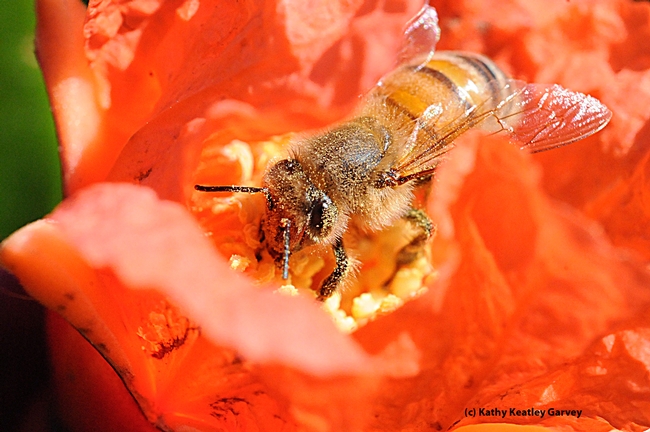
Honey bee foraging on pomegranate blossom. Pomegranate honey is the result.(Photos by Kathy Keatley Garvey)
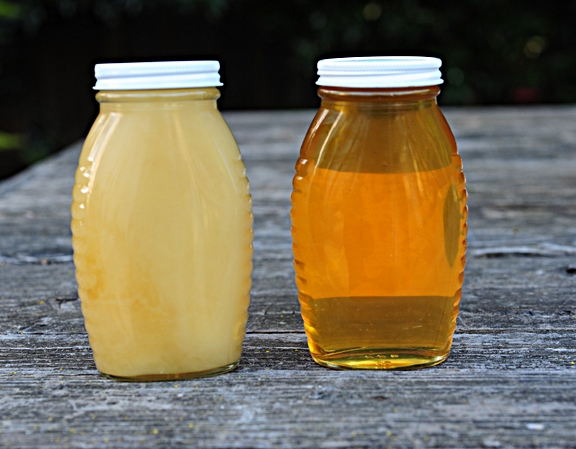
Starthistle honey: granulated or crystalized on the left; liquid honey on the right.
A honey of an event
Honey, sometimes described as the soul of a field of flowers, seized the spotlight at a recent benefit in Sacramento for UC Davis honey bee research.
The occasion: The Bee Informed event.
The site: The historic ballroom of the Citizen Hotel, Sacramento.
“Honey is one of my favorite ingredients to use in desserts because of its beautifully nuanced flavors and gorgeous colors,” said Bee Informed coordinator Elaine Baker (top left) of the Citizen Hotel/Grange Restaurant. “It’s just magical.”
The event, open to the public, raised $600 for the Häagen-Dazs Honey Bee Haven at the Harry H. Laidlaw Jr. Honey Bee Research Facility, UC Davis.
The event buzzed with bee and honey aficionados—and folks who just wanted to learn about bees and the products they produce.
For the occasion, Baker created mini-desserts made with Sacramento-area honey. Guests sipped cocktails laced with honey and sampled a variety of honey provided by area beekeepers. Honey ranged from dark buckwheat to a light tupelo. Tupelo is a honey that doesn’t granulate.
Baker, who blogs about food, came up with the idea of a “Bee Informed” event to raise public awareness about the plight of the honey bees.
Keynote speaker Eric Mussen (below), UC Davis extension apiculturist, updated the crowd about colony collapse disorder (CCD) and talked about the health of honey bees.
“The news media wrongfully reports that 33 percent to 35 percent of our nation’s honey bees are dying of CCD,” he said.
“Thirty-three to 35 percent is the average; only 25 percent of beekeepers have reported CCD in their colonies. Some lost 40, 80 or 100 percent of their hives due to CCD. So CCD is not killing 33 percent of our bees.”
CCD, the mysterious phenomenon characterized by adult bees abandoning the hive, may be due in part to an undiscovered microbe, but the malady “is going to be with us for awhile,” he said.
The Häagen-Dazs Honey Bee Haven, open to the public year around, is a half-acre bee friendly garden planted last fall next to the Laidlaw facility. It serves as a year-around food source for the Laidlaw bees and other pollinators; raises public awareness about the plight of bees; and provides educational opportunities for visitors, who can learn what to plant in their own yards to attract pollinations.
It is also a research garden; native pollinator specialist Robbin Thorp, emeritus professor of entomology, has found more than 50 species of bees, including leafcutter bees, metallic green sweat bees and bumble bees, at the site over the last two years.
Baker described the Bee Informed event as a great success. “Fantastic speakers, terrific vendors, delicious cocktails and desserts, not to mention all the beautiful honey.” A drawing for prizes included honey from Sacramento-area beekeepers and specially bottled honey made by UC Davis bees.
When asked to share one of her favorite honey recipes, she provided this one. Bon Appétit!
Buckwheat Honey Tea Bread
Makes 1 9x5” loaf
In a bowl whisk together:
2-1/4 cups all-purpose flour
3/4 cup sugar
1 tablespoon orange zest, finely chopped
2 teaspoons baking powder
1/2 teaspoon baking soda
1/2 teaspoon ginger
1/2 teaspoon cinnamon
1/2 teaspoon kosher salt
Set aside. In a mixer with a paddle attachment combine:
3/4 cup buckwheat honey
3/4 cup hot water
3 tablespoons brandy
4 tablespoons butter, melted
Blend on low until combined. Add dry ingredients and blend on low speed just until combined. Put into a greased 9x5” loaf pan. Bake at 350F about 50-60 min. or until the bread tests done and is a deep golden brown color. Remove from oven and let cool until barely warm, then remove from the pan. In a small saucepan heat up a small amount of the buckwheat honey with a little bit of water to make a glaze and brush on the top of the loaf. Let cool completely. This bread is best served the same day.
If you don’t have a mixer this recipe can also be mixed by hand. You can use any flavor of honey you like – wildflower, orange blossom, etc. Elaine Baker likes buckwheat honey because of the assertive flavor and beautiful color.
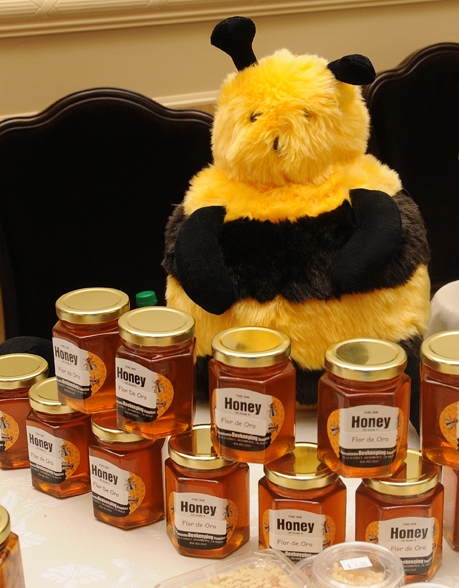
Show me the honey
Show me the honey
When the grand opening celebration of the Häagen-Dazs Honey Bee Haven at the University of California, Davis, takes place on Saturday, Sept. 11 from 10 a.m. to 2 p.m., this will also be a celebration of the honey bee.
The declining bee population, exacerbated by the mysterious disease called colony collapse disorder, makes us appreciate bees all the more. One-third of the food we eat is pollinated by bees.
Enter the Häagen-Dazs Honey Bee Haven.
Planted last fall next to the Harry H. Laidlaw Jr. Honey Bee Research Facility on Bee Biology Road, the honey bee haven is a half-acre bee friendly garden designed to provide a year-around food source for bees, increase awareness of the plight of the honey bee, and offer educational experiences for human visitors.
Visitors can learn the importance of honey bees and glean ideas on what to plant in their own gardens to attract bees and other pollinators. Here’s the award-winning design created by a Sausalito team. (Be sure to check out the Häagen-Dazs educational website.)
At the Sept. 11 grand opening, visitors also will gain a deeper appreciation of honey, sometimes called “the soul of a field of flowers.” Honey tasting, coordinated by Extension apiculturist Eric Mussen, member of the UC Davis Department of Entomology, is scheduled to be one of the activities at the celebration.
Of the more than 300 unique types of honey produced in the United States, among the most common floral sources are alfalfa, avocado, basswood, buckwheat, clover, eucalyptus, fireweed, orange blossom, safflower sages and tupelo.
A single bee can collect about 1/2 teaspoon of honey in her lifetime. To make a pound of honey, 560 worker bees must gather nectar from two million flowers, and fly a total of about 55,000 miles.
Like to cook with honey? Here are some recipes provided by the National Honey Board.
Applesauce Cake
1/2 cup butter, softened
1 cup honey
1 egg
1 teaspoon vanilla
1-1/4 cups all-purpose flour
1 cup whole wheat flour
1 teaspoon baking soda
?1 teaspoon ground cinnamon
1/2 teaspoon salt
1/2 teaspoon ground nutmeg
1/4 teaspoon ground cloves
1/4 teaspoon ground allspice or ginger
1 cup chopped dates
1/3 cup chopped walnuts
1 cup unsweetened applesauce
Cream butter in large bowl. Gradually beat in honey until light and fluffy. Add egg and vanilla; mix well. Combine dry ingredients in medium bowl; reserve 2 tablespoons flour mixture. Combine dates, walnuts and reserved 2 tablespoons flour mixture in small bowl; set aside. Add remaining flour mixture and applesauce alternately to creamed mixture, beginning and ending with flour mixture. Stir in date mixture. Pour batter into greased 13 x 9 x 2-inch pan. Bake at 325 degrees F for 35 minutes or until wooden pick inserted near center comes out clean.
Cranberry Oat Bread
3/4 cup honey
1/3 cup vegetable oil
2 eggs
1/2 cup milk
2-1/2 cups all-purpose flour
1 cup quick-cooking rolled oats
1 teaspoon baking soda?
1 teaspoon baking powder
1/2 teaspoon salt
1/2 teaspoon ground cinnamon
2 cups fresh or frozen cranberries
1 cup chopped nuts
Combine honey, oil, eggs and milk in large bowl; mix well. Combine flour, oats, baking soda, baking powder, salt and cinnamon in medium bowl; mix well. Stir into honey mixture. Fold in cranberries and nuts. Spoon into two 8-1/2 x 4-1/2 x 2-1/2-inch greased and floured loaf pans.
Bake in preheated 350 degrees oven 40 to 45 minutes or until wooden toothpick inserted near center comes out clean. Cool in pans on wire racks 15 minutes. Remove from pans; cool completely on wire racks. Makes 2 loaves.
Golden Cornbread
3 cups yellow cornmeal
1 cup whole wheat flour
2 tablespoons baking powder
1 teaspoon salt
2 cups buttermilk or low-fat yogurt
1/2 cup butter, melted
1/2 cup honey
3 eggs, beaten
Combine cornmeal, flour, baking powder and salt in large bowl. Combine buttermilk, butter, honey and eggs in separate large bowl. Stir buttermilk mixture into flour mixture just until moistened. Pour into greased 12x8x2-inch baking pan. Bake at 350 degrees for 25 minutes or until golden brown. Serves 8.

Honey Bee

The Beekeepers


